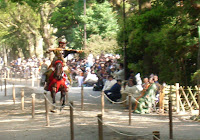
April 28, 2009
Small garden related to lullaby written by Empress Michiko
The small garden in a calm hillside residential area in uptown Tokyo was waiting for visitors in soft morning sunlight. An old gardener was busy cleaning the garden before visitors start appearing. The garden, “Nemunoki-no-niwa, or Silk Tree Garden, was opened by Shinagawa City in 2004 at part of a land lot formerly occupied by the residence of Empress Michiko’s parents. It is named after a lullaby written by Empress Michiko when she was a high school student.
Emperor Akihito and Empress Michiko visit the garden privately once a year. “Their majesties usually visit here in May or June,” the gardener said. Orange-colored roses of the kind named “Princess Michiko” are in full bloom around that time, he said.
Empress Michiko has composed many traditional waka poems. Small plates showing her poems linked to flowers are placed along the path in the garden.
A privately translated version of one of them follows:
I recall the summer day when I saw silk tree flowers after going up the hill of Kiire in the old Satsuma country
About 90 kinds of flowers are planted at the 570-square-meter garden. “I have been taking care of this garden since the opening,” the gardener told an elderly visitor, accompanied by her daughter, proudly. “You can enjoy flowers throughout the year. There are flowers for the four seasons here,” he said.
The Imperial couple celebrated their golden wedding anniversary on April 10. Emperor Akihito, in his 21st year on the throne, was the first emperor to receive his spouse from outside the Imperial family and the nobility. The chrysanthemum curtain between the Imperial family and the people was removed after Japan surrendered in WWII in 1945. The Imperial couple has been striving to forge a new style of relations with the people, just as their parents did. Their efforts will continue to make an Imperial family that fits today’s Japan as the family values are changing.
An author’s note: Satsuma is the old name for a part of the current Kagoshima Prefecture, Kyushu, southern Japan.




